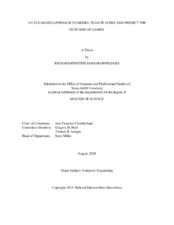| dc.description.abstract | Sports data analytics has become a popular research area in recent years, with the advent of different
ways to capture information about a game or a player. Different statistical metrics have been
created to quantify the performance of a player/team. A popular application of sport data anaytics
is to generate a rating system for all the team/players involved in a tournament. The resulting rating
system can be used to predict the outcome of future games, assess player performances, or come
up with a tournament brackets.
A popular rating system is the Elo rating system. It started as a rating system for chess tournaments.
It’s known for its simple yet elegant way to assign a rating to a particular individual.
Over the last decade, several variations of the original Elo rating system have come into existence,
collectively know as Elo-based rating systems. This has been applied in a variety of sports like
baseball, basketball, football, etc. In this thesis, an Elo-based approach is employed to model an
individual basketball player strength based on the plus-minus score of the player. The plus-minus
score is a powerful metric because it quantifies the contribution of a player like good defense,
setting up screens, or sledging the opposite team, which are not reflected by metrics that are primarilybased on points. Then, the individual player ratings are combined to obtain a team rating,
Team rating are compared pairwise to obtain the probability of a win by each of the teams during
a matchup. This method not only predicts wins/losses, but offers more information than the Elo
rating system as ratings are assigned to each individual player instead of just considering teams.
This information includes for example, the effect of mid-season transfers or the impact of injuries
to team strengths; these items are overlooked by the standard Elo algorithm.
The performance of the proposed Elo-based rating system is compared to that of the standard
Elo rating system for basketball by using sythetic data. The rating systems are also compared by
running them over real-life data from past NBA seasons. | en |


